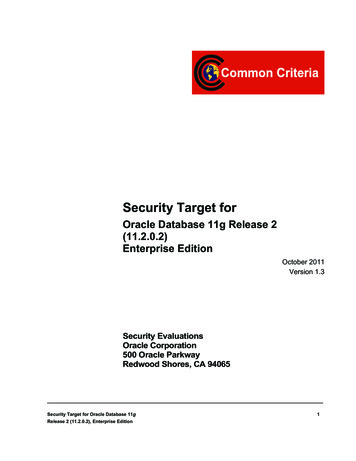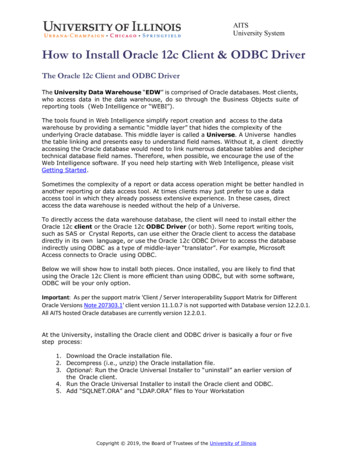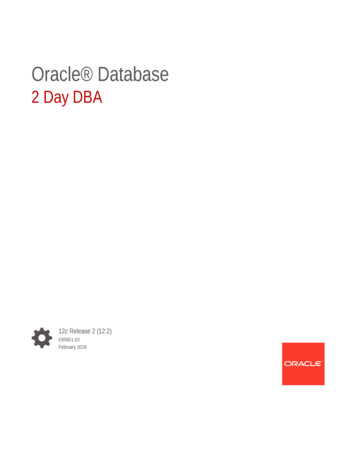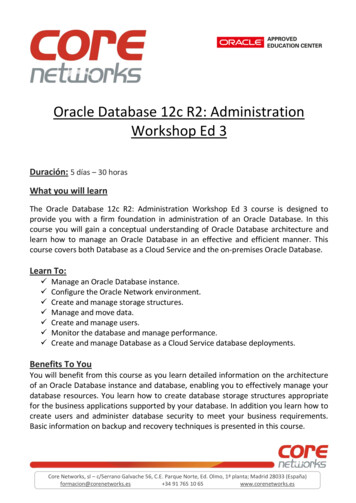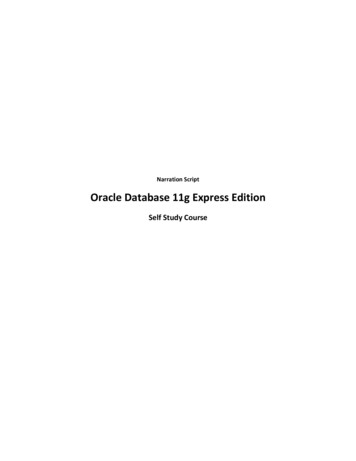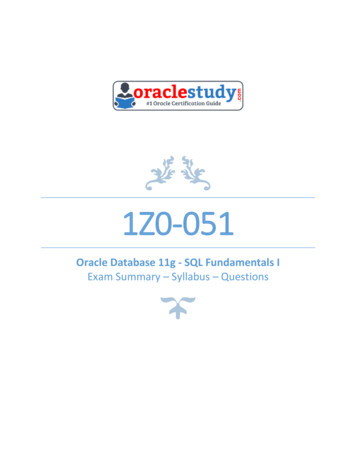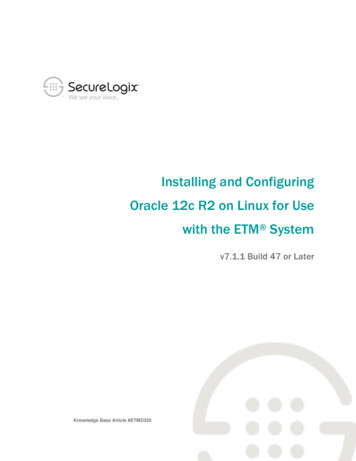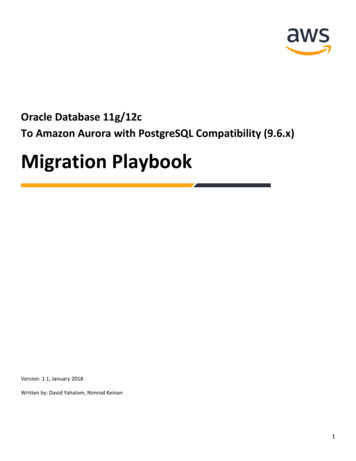
Transcription
Oracle Database 11g/12cTo Amazon Aurora with PostgreSQL Compatibility (9.6.x)Migration PlaybookVersion: 1.1, January 2018Written by: David Yahalom, Nimrod Keinan1
2017, Amazon Web Services, Inc. or its affiliates. All rights reserved. Document written by David Yahalom and NimrodKeinan.NoticesThis document is provided for informational purposes only. It represents AWS’s current product offerings and practicesas of the date of issue of this document, which are subject to change without notice. Customers are responsible formaking their own independent assessment of the information in this document and any use of AWS’s products orservices, each of which is provided “as is” without warranty of any kind, whether express or implied. This documentdoes not create any warranties, representations, contractual commitments, conditions or assurances from AWS, itsaffiliates, suppliers or licensors. The responsibilities and liabilities of AWS to its customers are controlled by AWSagreements, and this document is not part of, nor does it modify, any agreement between AWS and its customers.2
IntroductionTo migrate an Oracle database to Amazon Aurora with PostgreSQL Compatibility, you usually need to performboth automated and manual tasks. The automated tasks involve data migration and schema conversion usingthe AWS Database Migration Service (AWS DMS) and AWS Schema Conversion Tool (AWS SCT). The manualtasks involve post-migration “touch-ups” for certain database objects that can’t be migrated automatically.This whitepaper primarily focuses on the manual aspects of database migration and includes step-by-stepinstructions that you can adapt for your own requirements. In this document, we focus on how to manuallymigrate specific Oracle database objects and features to Amazon Aurora with PostgreSQL Compatibilityequivalents. We also include a brief overview that explains how to use the AWS Schema Conversion Tool (AWSSCT) for automatic migrations of schema objects. You can use this document as a supplementary guide foryour database migrations – both as a guide to expand your PostgreSQL competency if you come from anOracle database background and as a reference to help build Oracle-comparable functionality in AmazonAurora with PostgreSQL compatibilityThis document does not yet cover all Oracle Database features and capabilities from a migration perspective.For the first release, we focus on some of the most important features and will continue to expand thePlaybook document over time. Not all Oracle features have direct and fully compatible equivalents inPostgreSQL. In these cases, we present our recommendations for the best-possible equivalent features inAmazon Aurora with PostgreSQL compatibility.We also plan to expand this document in the future and add new chapters specifically dedicated to advancedtopics such as Oracle security, High Availability and Disaster Recovery, Performance Tuning, and more.DisclaimerThe various code snippets, commands, guides, best practices, and scripts included in this document should beused for reference only and are provided as-is without warranty. Please be sure to test all of the code,commands, best practices, and scripts outlined in this document in a non-production environment first.Amazon and its affiliates are not responsible for any direct or indirect damage that can occur from theinformation contained in this document.3
Automatic Schema MigrationHelp SectionLinkUsing the AWS Schema Conversion Tool for automatic schema conversionSQL & PL/SQL (Manual)Oracle kLinkLinkLinkLinkLinkLinkAnonymous BlockExecute ImmediateDBMS RANDOMDBMS OUTPUTProcedures & FunctionsUser Defined Functions(UDFs)UTL FILEJSON Document SupportOLAP FunctionsPL/SQL CursorsSingle Row & AggregateFunctionsMergeCreate Table As Select (CTAS)Common Table Expression(CTE)Insert From SelectInline ViewsDB HintsAurora PostgreSQLFeatureCompatibilityDoExecute & sYes*Yes*N/AJSON Document SupportWindow FunctionsCursorsSingle Row & AggregateFunctionsSQL MergeCreate Table As Select (CTAS)Common Table Expression(CTE)Insert From SelectInline ViewsQuery PlanningNoneYes*YesYesYesYesYesYesYesYesYes*4
Tables & Indexes (Manual)Oracle FeatureLinkLinkIndex Organized Tables (IOTs)Common Data TypesLinkLinkTable ConstraintsTable Partitioning including:RANGE, LIST, HASH,COMPOSITE, Automatic LISTExchange and Split PartitionsTemporary TablesUnused ColumnsVirtual kLinkLinkLinkLinkLinkLinkUser Defined Types (UDTs)Read Only Tables and TablePartitionsIndex TypesB-Tree IndexesComposite IndexesBITMAP IndexesFunction-Based IndexesLocal and Global PartitionedIndexesIdentity ColumnsMVCC(Table and Row Locks)Character SetsTransaction ModelLOBs and SecureFile LOBsAurora PostgreSQLFeatureCompatibilityPostgreSQL “Cluster” TablesCommon Data TypesYes*YesTable ConstraintsTable Partitioning including:RANGE, LISTYesYes*N/ATemporary TablesALTER TABLE DROP COLUMNViews and/or Function as aColumnUser Defined Types (UDTs)Read Only Roles and/orTriggersIndex TypesB-Tree IndexesMulti-Column IndexesBRIN IndexesExpression IndexesPartitioned es*Serial Data TypeMVCC(Table and Row Locks)EncodingTransactional ModelLOBsYes*Yes*Aurora PostgreSQLFeatureCompatibilityYes*Yes*Yes*Database Objects (Manual)Oracle FeatureLinkLinkLinkLinkLinkMaterialized ViewsCommon Data TypesOracle TriggersViewsSequencesMaterialized ViewsCommon Data TypesPostgreSQL Trigger ProcedureViewsSequencesYes*YesYes*YesYes5
LinkDatabase LinksPostgreSQL DBLink andFDWrapperYes*6
Database Administration (Manual)Oracle FeatureLinkLinkLinkLinkRecovery Manager (RMAN)Flashback Database12c Multi-TenantArchitecture: PDBs and CDBTablespaces and DataFilesLinkLinkData PumpResource ManagerLinkLinkLinkLinkDatabase UsersDatabase RolesSGA & PGA MemoryV Views & the DataDictionaryLinkLinkLog MinerInstance & DatabaseParameters (SPFILE)Session ParametersAlert.log (error log)LinkLinkLinkLinkAutomatic and ManualStatistics CollectionViewing Execution PlansAurora PostgreSQLFeatureCompatibilityAmazon Aurora SnapshotsAmazon Aurora SnapshotsDatabasesYesYesYes*TablespacesYes*pg dump and pg restoreSeparate Amazon AuroraClustersDatabase RolesDatabase RolesMemory BuffersSystem Catalog Tables,Statistics Collector, AmazonAurora Performance InsightsLogging OptionsAmazon Aurora ParameterGroupsSession ParametersError Log via AWSManagement ConsoleAutomatic and ManualStatistics CollectionViewing Execution PlansYesYesYesYesYesYes*YesYesYesYesYesYes7
Automatic Migration of Oracle Schema ObjectsUsing the AWS Schema Conversion Tool8
Automatic Schema Migration[Back to TOC]This section provides a step-by-step process for using the AWS Schema Conversion Tool (AWS SCT) to migratean Oracle database to an Aurora with PostgreSQL compatibility database cluster. Amazon SCT canautomatically migrate most of the database objects.While this document primarily covers the best practices, feature-parity aspects of manual databasemigrations, and Oracle to Amazon Aurora with PostgreSQL compatibility migration best practices, werecommend using AWS SCT as the first step of the process.AWS SCT is a downloadable Java utility that runs locally on your computer. It connects to the source andtarget databases, scans the source database schema objects (tables, views, indexes, procedures, etc.), andconverts them to the target database objects.For more information, /latest/userguide/Welcome.html9
Download AWS SCT and Install JDBC DriversJDBC drivers are required for database connectivity to both the source and target databases.1. Download l/latest/userguide/CHAP SchemaConversionTool.Installing.html2. Download the Oracle JDBC Driver 347.html3. Download the PostgreSQL JDBC Driver gresql.org/download.htmlConfigure SCT for Database Migration1. Launch SCT.2. Choose the JAR files path under SCTs Global Settings3. Click Global Settings Drivers4. Add the file path to the Oracle and the PostgreSQL JDBC drivers5. Use the following filenames:Oracle JDBC JAR- ojdbc7.jarPostgreSQL JDBC JAR - postgresql-9.4-1204.jdbc42.jar6. Click OK.10
AWS SCT – Database Migration Project ConfigurationCreate a new SCT project which will guide you, step-by-step, through the schema conversion process.1. Click SCT File New Project Wizard2. Select a source database for migration (the Oracle Database to migrate to Aurora with PostgreSQLCompatibility).3. Enter a project name, specify the location of the SCT project files, choose the source databaseworkload characteristics (OLTP or OLAP), and select the source database engine (Oracle).11
4. Configure the source database connection properties: Server hostnameOracle Net Listener port numberOracle Database SIDPrivileged username and password. For example, the Oracle system user.5. Click Next.6. Select the source Oracle schema for migration.12
7. SCT analyzes the source database schema objects and produces the Database MigrationAssessment report. Review the report.8. Specify the target database configuration: Target Database Engine: Amazon Aurora (PostgreSQL compatible).Server hostname: Aurora Cluster Endpoint.Server port number: 5432 (default PostgreSQL network port).Database: The name of the target database that will store the migrated schema objects.The privileged target database username and password. Deployment of the convertedschema in the target database will use these credentials.13
9. Click Finish when you are done. Note that at this stage in the process the migrated target schemahas not yet been deployed to your target database.10. Explore the AWS SCT Project Main Page and the other information pages. Select Oracle schemaobjects from the left Oracle pane to view the Oracle syntax.Source - OracleSchema DetailsSource - OracleObject DetailsTarget -PostgreSQLObject DetailsTarget - PostgreSQLSchema Details14
AWS SCT – Database Migration Assessment1. Explore the objects in your source database and be sure to note any database objects that SCTcannot automatically migrate to your target database syntax. SCT flags objects with potentialmigration issues with a RED exclamation mark. These objects require manual intervention forsuccessful migration.2. Right click the Oracle schema for migration and select Create Report to view the completeDatabase Migration Assessment report.3. Click the Action Items tab. This section of the report provides information about potentialmigration issues.15
4. Click the migration issues highlighted by SCT to view a detailed overview of the exact source syntaxthat failed the automatic migration process.16
AWS SCT – Convert Source to Target Database SyntaxThis step converts the source database schema objects to your target database using target database syntax.1. Right click the Oracle Schema and select Convert Schema.2. The new schema and objects appear in the right-side pane under the target database. Compare thesource database objects (left-side pane) to the converted target database objects (right-side pane).Note that the converted schema has not yet been deployed to the target PostgreSQL database.3. Examine any gaps in objects that AWS SCT could not automatically convert.17
AWS SCT – Deploy the Converted Schema to the Target Database1. In the right-side Target Database pane, right click the PostgreSQL schema corresponding to thesource database schema name.2. Select Apply to database.3. Click Yes to continue. This step creates the new schema in the target database.18
Manual Migration and Best Practices ofOracle Schema Objects and Database Features19
Migrating from: Oracle Anonymous Block[Back to TOC]OverviewOracle’s PL/SQL is a procedural extension of SQL. The PL/SQL program structure divides the code into blocksthat can be distinguished by the following keywords: DECLARE, BEGIN, EXCEPTION, and END.An unnamed PL/SQL code block (code not stored in the database as a procedure, function, or package) isknown as an anonymous block. An anonymous block serves as the basic unit of Oracle PL/SQL and containsthe following code sections: The Declarative Section (Optional)Contains variables (names, data types, and initial values). The Executable Section (Mandatory)Contains executable statements (each block structure must contain at least one executable PL/SQLstatement). The Exception-Handling Section (Optional)Contains elements for handling exceptions or errors in the code.ExamplesSimple structure of an Oracle Anonymous Block:SQL SET SERVEROUTPUT ON;SQL BEGINDBMS OUTPUT.PUT LINE('hello world');END;/hello worldPL/SQL procedure successfully completed.20
Oracle PL/SQL Anonymous blocks can contain advanced code elements such as functions, cursors, dynamicSQL, and conditional logic. The following anonymous block uses a cursor, conditional logic, and exceptionhandling:SQL SET SERVEROUTPUT ON;SQL DECLAREv sal chkNUMBER;v emp work years NUMBER;v sql cmdVARCHAR2(2000);BEGINFOR v IN (SELECT EMPLOYEE ID, FIRST NAME ' ' LAST NAME ASEMP NAME, HIRE DATE, SALARY FROM EMPLOYEES)LOOPv emp work years: EXTRACT(YEAR FROM SYSDATE) - EXTRACT (YEAR FROMv.hire date);IF v emp work years 10 and v.salary 6000 thenDBMS OUTPUT.PUT LINE('Consider a Bonus for: ' v.emp name);END IF;END LOOP;EXCEPTION WHEN OTHERS THENDBMS OUTPUT.PUT LINE('CODE ERR: ' sqlerrm);END;/The above example calculates the years each employee has worked based on the HIRE DATE column of theEMPLOYEES table. If the employee has worked for ten or more years and has a salary of 6000 or less, thesystem prints the message “Consider a Bonus for: employee name ”.For additional details:https://docs.oracle.com/cd/B28359 H21
Migration to: PostgreSQL DO[Back to TOC]OverviewPostgreSQL version 9.6 supports capabilities similar to Oracle’s anonymous blocks. In PostgreSQL, you canexecute PL/pgSQL code that is not stored in the database as an independent code segment using a PL/pgSQLDO statement.PL/pgSQL is a PostgreSQL extension to the ANSI SQL and has many similar elements to Oracle PL/SQL.PostgreSQL DO uses a similar code structure to an Oracle anonymous block: Declarative Section (Optional)Executable Section (Mandatory)Exception-Handling Section (Optional)ExamplesPostgreSQL DO simple structure:psql SET CLIENT MIN MESSAGES 'debug';-- Equivalent To Oracle SET SERVEROUTPUT ONpsql DO BEGINRAISE DEBUG USING MESSAGE : 'hello world';END ;DEBUG:DOhello worldThe PostgreSQL PL/pgSQL DO statement supports the use of advanced code elements such as functions,cursors, dynamic SQL, and conditional logic.22
The following example is a more complex PL/pgSQL DO code structure converted from Oracle’s “employeebonus” PL/SQL anonymous block example presented in the previous section:psql DO DECLAREv sal chk DOUBLE PRECISION;v emp work years DOUBLE PRECISION;v sql cmd CHARACTER VARYING(2000);v RECORD;BEGINFOR v INSELECT employee id, CONCAT WS('', first name, ' ', last name) ASemp name, hire date, salaryFROM employeesLOOPv emp work years : EXTRACT (YEAR FROM now()) - EXTRACT (YEAR FROMv.hire date);IF v emp work years 10 AND v.salary 6000 THENRAISE DEBUG USING MESSAGE : CONCAT WS('', 'Consider a SalaryRaise for: ', v.emp name);END IF;END LOOP;EXCEPTIONWHEN others THENRAISE DEBUG USING MESSAGE : CONCAT WS('', 'CODE ERR: ',SQLERRM);END ;For additional information on PostgreSQL sql-do.html23
Migrating from: Oracle EXECUTE IMMEDIATE[Back to TOC]OverviewOracle’s EXECUTE IMMEDIATE statement can be used to parse and execute a dynamic SQL statement or ananonymous PL/SQL block. It also supports bind variables.ExampleRun a dynamic SQL statement from within a PL/SQL procedure:1. Create a PL/SQL procedure named raise sal.2. Define a SQL Statement with a dynamic value for the column name included in the where statement.3. Use the EXECUTE IMMEDIATE command supplying the two bind variables to be used as part of theSELECT statement:- amount- col valCREATE OR REPLACE PROCEDURE raise sal (col val NUMBER,emp col VARCHAR2, amount NUMBER) IScol name VARCHAR2(30);sql stmtVARCHAR2(350);BEGIN-- determine if a valid column name has been given as inputSELECT COLUMN NAME INTO col name FROM USER TAB COLSWHERE TABLE NAME 'EMPLOYEES' AND COLUMN NAME emp col;-- define the SQL statment (with bind variables)sql stmt : 'UPDATE employees SET salary salary :1 WHERE ' col name ' :2';-- Execute the commandEXECUTE IMMEDIATE sql stmt USING amount, col val;END raise sal;/4. Run the DDL operation from within an EXECUTE IMMEDIATE command:EXECUTE IMMEDIATE 'CREATE TABLE link emp (idemp1 NUMBER, idemp2 NUMBER)';EXECUTE IMMEDIATE 'ALTER SESSION SET SQL TRACE TRUE';5. Run an anonymous block with bind variables using EXECUTE IMMEDIATE:EXECUTE IMMEDIATE 'BEGIN raise sal (:col val, :col name, :amount); END;'USING 134, 'EMPLOYEE ID', 10;For additional /dynamic.htm#LNPLS0111524
Migration to: PostgreSQL PL/pgSQL Execute & Prepare[Back to TOC]OverviewThe PostgreSQL EXECUTE command prepares and executes commands dynamically. The EXECUTE commandcan also run DDL statements and retrieve data using SQL commands. Similar to Oracle, the PostgreSQLEXECUTE command can be used with bind variables.Example1. Execute a SQL SELECT query with the table name as a dynamic variable using bind variables. This queryreturns the number of employees under a manager with a specific ID.DO DECLARETabnamevarchar(30) : 'employees';numinteger : 1;cntinteger;BEGINEXECUTE format('SELECT count(*) FROM %I WHERE manager 1', tabname)INTO cntUSING num;RAISE NOTICE 'Count is % int table %', cnt, tabname;END ;;2. Execute a DML command – first with no variables and then with variables:DO DECLAREBEGINEXECUTE 'INSERT INTO numbers (a) VALUES (1)';EXECUTE format('INSERT INTO numbers (a) VALUES (%s)', 42);END ;;Notes %s formats the argument value as a simple string. A null value is treated as an empty string. %I treat the argument value as an SQL identifier and double-quoting it if necessary. It is an error forthe value to be null.3. Execute a DDL command:DO DECLAREBEGINEXECUTE 'CREATE TABLE numbers (num integer)';END ;;For additional /functions-string.html25
PostgreSQL PrepareUsing a PREPARE statement can improve performance for reusable SQL statements.The PREPARE command can receive a SELECT, INSERT, UPDATE, DELETE, or VALUES statement andparse it with a user-specified qualifying name so the EXECUTE command can be used later without the needto re-parse the SQL statement on each execution. When using PREPARE to create a prepared statement, it will be viable for the scope of the currentsession.If a DDL command is executed on a database object referenced by the prepared SQL statement, thenext EXECUTE command requires a hard parse of the SQL statement.ExampleUse PREPARE and EXECUTE commands in tandem:The SQL command is prepared with a user-specified qualifying name.The SQL command is executed several times, without the need for re-parsing.PREPARE numplan (int, text, bool) ASINSERT INTO numbers VALUES( 1, 2, f');'t');PL/pgSQL EXECUTE vs. Oracle implicit cursorFunctionalityPostgreSQL - EXECUTEOracle – EXECUTE IMMEDIATEExecute SQLwith resultsand bindvariablesEXECUTE format('select salaryfrom employees WHERE %I 1',col name) INTO amount USINGcol val;EXECUTE IMMEDIATE 'select salaryfrom employees WHERE ' col name ' :1' INTO amount USINGcol val;Execute DMLwith variablesand bindvariablesEXECUTE format('UPDATE employeesSET salary salary 1 WHERE%I 2', col name) USINGamount, col val;EXECUTE IMMEDIATE 'UPDATEemployees SET salary salary :1WHERE ' col name ' :2'USING amount, col val;Execute DDLEXECUTE 'CREATE TABLE link emp(idemp1 integer, idemp2integer)';DO DECLAREBEGIN.END ;EXECUTE IMMEDIATE 'CREATE TABLElink emp (idemp1 NUMBER, idemp2NUMBER)';EXECUTE IMMEDIATE ‘BEGINDBMS OUTPUT.PUT LINE(‘’AnonymousBlock’’); END;’;ExecuteAnonymousblockFor additional atic/plpgsql-statements.html26
Migrating From: Oracle DBMS RANDOM[Back to TOC]OverviewOracle’s DBMS RANDOM package enables you to generate a random number or string as part of a SQLstatement or PL/SQL procedure.DBMS RANDOM Package Stored Procedures include:1. NORMAL – returns random numbers in a standard normal distribution.2. SEED – resets the seed that generates random numbers or strings.3. STRING – returns a random string.4. VALUE – returns a number that is greater than or equal to 0 and less than 1 with 38 digits to theright of the decimal. Alternatively, you could get a random Oracle number that is greater than orequal to a low parameter and less than a high parameter.Notes: DBMS RANDOM.RANDOM produces integers in [-2 31, 2 31).DBMS RANDOM.VALUE produces numbers in [0,1] with 38 digits of precision.Example1. Generate a random number:SQL select dbms random.value() from dual;DBMS RANDOM.VALUE()------------------.859251508SQL select dbms random.value() from dual;DBMS RANDOM.VALUE()------------------.36479238727
2. Generate a random string. The first character determines the returned string type and the numberspecifies the length:SQL select dbms random.string('p',10) from dual;DBMS ------------------------la'?z[Q&/2SQL select dbms random.string('p',10) from dual;DBMS ------------------------t?!Gf2M60qFor additional /d random.htm28
Migration To: PostgreSQL random()[Back to TOC]OverviewPostgreSQL does not provide a dedicated package equivalent to Oracle DBMS RANDOM – a 1:1 migration isnot possible. However, other PostgreSQL functions can be used as workarounds under certain conditions. Forexample, generating random numbers can be performed using the random() function. For generatingrandom strings, you can use the value returned from the random() function coupled with an md5()function.Example1. Generate a random number:mydb select (1 row)mydb select (1 row)2. Generate a random string:mydb select ------f83e73114eccfed571b43777b99e0795(1 row)mydb select ------d46de3ce24a99d5761bb34bfb6579848(1 row29
Oracle dbms random vs. PostgreSQL random()DescriptionGenerate a randomnumberGenerate a randomnumber between 1 to100Generate a randomstringOracleselect dbms random.value()from dual;selectdbms random.value(1,100)from dual;selectdbms random.string('p',10)from dual;PostgreSQLselect random();Generate a randomstring in upper caseselectdbms random.string('U',10)from dual;selectupper(md5(random()::text));select random()*100;select md5(random()::text);For additional /docs/current/static/functions-string.html30
Migrating from: Oracle DBMS OUTPUT[Back to TOC]OverviewOracle’s DBMS OUTPUT package is typically used for debugging or for displaying output messages fromPL/SQL procedures.ExampleIn the following example, DBMS OUTPUT with PUT LINE is used with a combination of bind variables todynamically construct a string and print a notification to the screen from within an Oracle PL/SQL procedure.In order to display notifications on to the screen, you must configure the session with SET SERVEROUPUTON.SET SERVEROUTPUT ONDECLARECURSOR c1 ISSELECT last name, job id FROM employeesWHERE REGEXP LIKE (job id, 'S[HT] CLERK')ORDER BY last name;v lastname employees.last name%TYPE; -- variable to store last namev jobidemployees.job id%TYPE;-- variable to store job idBEGINOPEN c1;LOOP -- Fetches 2 columns into variablesFETCH c1 INTO v lastname, v jobid;DBMS OUTPUT.PUT LINE ('The employee id is:' v jobid ' and hislast name is:' v lastname);EXIT WHEN c1%NOTFOUND;END LOOP;CLOSE c1;END;In addition to the output of information on the screen, the PUT and PUT LINE procedures in theDBMS OUTPUT package enable you to place information in a buffer that can be read later by another PL/SQLprocedure or package. You can display the previously buffered information using the GET LINE andGET LINES procedures.For additional /d output.htm#ARPLS03631
Migration to: PostgreSQL RAISE[Back to TOC]OverviewThe PostgreSQL RAISE statement can be used as an alternative to DBMS OUTPUT. You can combine RAISEwith several levels of severity INGERRORLOGFATALPANICProvides successively-more-detailed information for use by developers.Provides information implicitly requested by the userProvides information that might be helpful to usersProvides warnings of likely problemsReports an error that caused the current command to abort.Reports information of interest to administrators, e.g., checkpoint activity.Reports an error that caused the current session to abort.Reports an error that caused all database sessions to abort.Examples1. Use RAISE DEBUG (where DEBUG is the configurable severity level) for similar functionality as Oracle’sDBMS OUTPUT.PUT LINE feature.psql SET CLIENT MIN MESSAGES 'debug';-- Equivalent To Oracle SET SERVEROUTPUT ONpsql DO BEGINRAISE DEBUG USING MESSAGE : 'hello world';END ;DEBUG:DOhello world2. Use the client min messages parameter to control the level of message sent to the client. Thedefault is NOTICE. Use the log min messages parameter to control which message levels arewritten to the server log. The default is WARNING.SET CLIENT MIN MESSAGES 'debug';For additional atic/plpgsql-errors-and-messages.htmlFor additional GES32
Oracle DBMS OUTPUT.PUT LINE vs. PostgreSQL RAISEFeatureDisables message outputEnables message outputOracleDISABLEENABLERetrieves one line frombufferRetrieves an array of linesfrom bufferTerminates a line createdwith PUTPlaces a partial line in thebufferGET LINEPlaces line in bufferPUT LINEdo DECLAREmessage varchar : '';beginmessage : message '1,';message : message '2,';message : message '3,';message : message '4';RAISE NOTICE '%',message;END ;RAISEDBMS OUTPUT.PUT LINE('The employee id is:' v jobid ' and his lastname is:' v lastname);RAISE NOTICE 'The employeeid is: % and his last nameis: %', v jobid,v lastname;SQLCODE SQLERRMSQLSTATE SQLERRMDECLARENameemployees.last name%TYPE;BEGINSELECT last name INTOnameFROM employees WHEREemployee id -1;EXCEPTIONWHEN OTHERS thenDBMS OUTPUT.PUT LINE('Errorcode ' SQLCODE ': ' sqlerrm);END;/do declareName employees%ROWTYPE;BEGINSELECT last name INTOnameFROM employees WHEREemployee id -1;EXCEPTIONWHEN OTHERS thenRAISE NOTICE'Error code %: %',sqlstate, sqlerrm;end ;Returns the number code ofthe most recent exceptionReturns the error messageassociated with its errornumber argument.GET LINESPUT NEW LINEBEGINDBMS OUTPUT.PUT ('1,');DBMS OUTPUT.PUT('2,');DBMS OUTPUT.PUT('3,');DBMS OUTPUT.PUT('4');DBMS OUTPUT.NEW LINE();END;/PostgreSQLConfigure “client min message”or “log min message” for thedesired resultsConsider storing messages in an array ortemporary table so that you can retrievethem from another procedure orpackageStore and concatenate the messagestring in a varchar variable before raisingFor additional /errcodes-appendix.html33
Migrating from: Oracle Procedures and Functions[Back to TOC]OverviewOracle PL/SQL is Oracle’s built-in database programming language providing several methods to store andexecute reusable business logic from within the database. Procedures and functions are reusable snippets ofcode created using the CREATE PROCEDURE and the CREATE FUNCTION statements.Stored Procedures and Stored Functions are PL/SQL units of code consisting of SQL and PL/SQL statementsthat solve specific problems or perform a set of related tasks. Procedure – used to perform database actions with PL/SQL.Function – used to perform a calculation and return a result.Privileges for Creating Procedures and Functions To create procedures and functions in their own schema, Oracle database users must have theCREATE PROCEDURE system privilege.To create procedures or functions in other schemas, the database user must have the CREATEANY PROCEDURE privilege.To execute a procedure or function, the database user must have the EXECUTE privilege.Package and Package BodyIn addition to stored procedures and functions, Oracle also provides “Packages” that encapsulate relatedprocedures, functions, and other program objects. Package: declares and describes all the related PL/SQL elements.Package body: contains the executable code.To execute a stored procedure or function created inside a package, the package name and the storedprocedure or function name must be specified.SQL EXEC PKG EMP.CALCULTE SAL('100');34
Examples1. Create an Oracle stored procedure using the CREATE OR REPLACE PROCEDUER statement. Theoptional OR REPLACE clause overwrites an existing stored procedure with the same name, if exists.SQL CREATE OR REP
1 . Oracle Database 11g/12c To Amazon Aurora with PostgreSQL Compatibility (9.6.x) Migration Playbook . Version: 1.1


